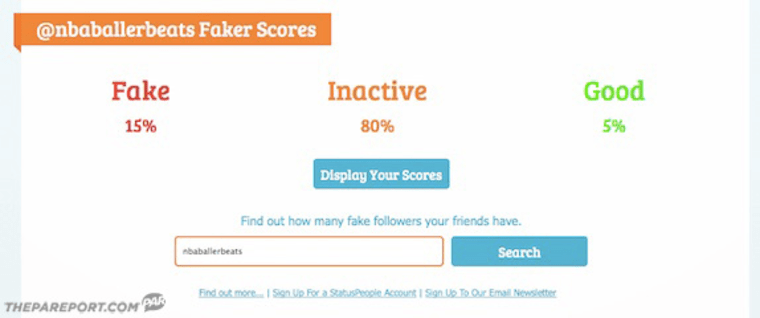“There has never been anything like NBA Baller Beats, which is a true game-changer for the industry,” said Jesse Sutton, Chief Executive Officer, Majesco Entertainment in a press release. “The buzz for the game is growing each day and it already has 4 million video views and nearly 700,000 Twitter followers. We are really looking forward to all the fans playing the game when it is in stores tomorrow.” That quote is from a press release I received earlier today.
Alarm bells went off. To give you some sense of scale, the official Twitter account for Assassin’s Creed has around 130,000 followers. Call of Duty, arguably the biggest video game franchise in the world, has “only” 546,000 followers. It seemed unlikely to me that a smaller game from Majesco so handily beat the biggest names in gaming in terms of Twitter followers. My suspicions were confirmed when I started looking into the follower count for the game; most followers seemed to be either bots or shell accounts, many of them had never tweeted a single thing.
That’s what it looks like when a developer, or publisher, buys followers.
There had to be a way to look at the over half-million followers to see how many actually existed. I decided to try a site called Status People, but first I wanted to find the baseline. Why not start with my own Twitter account? I’m active on Twitter, perhaps to a fault, and I’ve never bought followers or used any non-organic techniques to boost my count. The site claimed 66 percent of my followers were “good,” 30 percent were “inactive,” and only 4 percent were “fake.” Not bad!
I then plugged in Justin McElroy’s name. McElroy works for Polygon.com, and hosts the popular podcast “My Brother, My Brother, and Me.” He’s a pretty public guy and does a great job of interacting with his audience via Twitter. Not surprisingly, 62 percent of his followers were good, 32 percent were inactive, and only 4 percent were fake. That’s a pretty good outcome.
Things are a little less cut and dry when you get into the bigger, official accounts, but the numbers are still telling. The Assassin’s Creed twitter account was a little trickier. 43 percent of the followers were “good,’ 42 percent were “inactive,” and 15 percent were “fake.” Call of Duty enjoys 46 percent “good” followers, 37 percent “inactive,” and 17 percent “fake.”

Only 5 percent of the game's followers qualified as 'good'
Looking at the stats for NBA Baller Beats’ account, only 5 percent were “good,” with 15 percent showing up as “fake” and a stunning 80 percent showing as “inactive.” It’s important to note that the site only looks at a limited number of followers, so the data is not complete, but it’s still a solid sample from which to draw conclusions. “We take a sample of your follower data. Up to 1,000 records depending on how ‘popular’ you are and assess them against a number of simple spam criteria,” the site explains. “On a very basic level spam accounts tend to have few or no followers and few or no tweets. But in contrast they tend to follow a lot of other accounts.”
I wanted more evidence, so I then looked at stats on Twitter Counter, using my own account and Assassin’s Creed’s account as a control. In a month from August 12th to September 12th, I gained between 15 and 30 followers a day at a steady rate. Assassin’s Creed gained followers at between 250 to 300 followers a day. Not bad at all, a steady growth of organic followers.
This is where it gets weird. According to Twitter Counter, NBA Baller Beats had 214,429 followers on August 19. The account then gained exactly 21,321 followers per day moving forward. Never more, never less. Every day. It’s possible that uniform number is a result of an oddity in the Twitter Counter’s software, but the fact the Twitter count began to move up so aggressively on a specific day is incredibly suspicious. It’s not a spike, but steady, rapid growth.
On August 19, the follower count began a steady and non-varying climb, adding 21,321 followers a day
Deceptive business practices are bad news in the world of PR, especially when the story of trying to trick people into thinking your game is bigger than it is becomes the story. It’s not strange that Majesco or one of its PR companies thought this was a good idea, what’s odd is that numbers are so immediately suspect, and they were used as part of the marketing campaign.
We reached out to Majesco for comment. “We are pleased at the reception NBA Baller Beats has gotten via YouTube and Twitter, especially given the support of high profile media outlets and athletes. As with any Twitter account, bots do invade,” Christina Glorioso, CMO, Majesco Entertainment, stated. “We did not buy or instigate any followers, but since its been brought to our attention we are actively working with Twitter to remove and block any automated accounts.”
The New York Times ran a story about buying Twitter followers, stating the ease and low cost of padding your count for marketing and PR purposes. “The practice is surprisingly easy. A Google search for “buy Twitter followers” turns up dozens of web sites like USocial.net, InterTwitter.com, and FanMeNow.com that sell Twitter followers by the thousands (and often Facebook likes and YouTube views). At BuyTwitterFollow.com, for example, users simply enter their Twitter handle and credit card number and, with a few clicks, see the ranks of their followers swell in three to four days,” the article stated.
We can’t be sure that Twitter followers were purchased, but the evidence is hard to deny, and that sort of trick doesn’t instill much confidence in the game being sold. You rarely see other companies bragging about the number of Twitter followers they have, and the fact that NBA Baller Beats was supposed to have more followers than Call of Duty and Assassin’s Creed combined makes us very skeptical of their follower count. If legit, this was one of the most successful PR campaigns in the history of gaming, leap-frogging the industry’s biggest franchises. Unfortunately, the evidence points to a shadier reality.
More from our friends at The Penny Arcade Report
